
End time: 6 hours
Gonzo blogging from the Annie Leibovitz of the software development world.
Grabbed a copy of IE8 and installed it. I like to live dangerously. Here's some first thoughts.
Developer Toolbar
I have the IE developer toolbar installed so I can mess around with sites. It's still a toolbar, but in IE8 everything has become a giant popup like this:
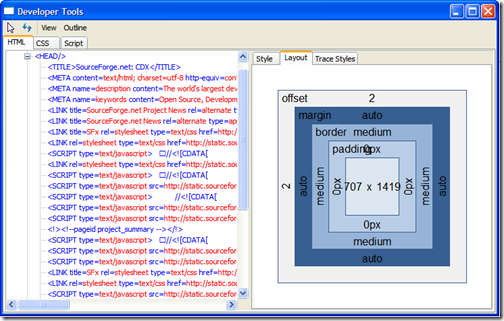
I remember this being a docked window in IE7. You can't select "Outline | Table Cells or Tables" anymore and when you do select to outline an element, it's wrong. Also when you click on the page, the popup goes away now. Not very useful anymore IMHO. So much for that little tool.
Web Slices
This is a new feature in IE8 and let's you "slice" part of a web page for later retrieval. WebSlices allow users to connect to websites by subscribing to content directly within a webpage. WebSlices behave just like feeds where clients can subscribe to get updates and notify the user of changes. A WebSlice is a portion within a webpage that is treated like a subscribe-able item, just like a feed. To enable a WebSlice on your website, annotate your webpage with class names for the title, description, and other subscribe-able properties.
When you add a web slice to IE8 you get a link added to your Links (I never use these) but it's not just a link to the page, it'll create a menu that previews the content you've sliced. They have an example where you can slice the content from Facebook
Here's a web slice I created in this blog entry:
If you're viewing this in IE8 you'll see the little icon hover over the section above and paint a faint box around it.

Click on the icon it and it'll let you add it as a slice.
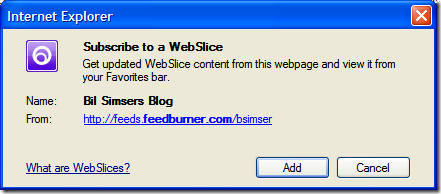
Consider it my slice of life I give to you today, free of charge.
Anywho, now in your Links Toolbar, you'll see the entry for the slice you just created and subscribed to.
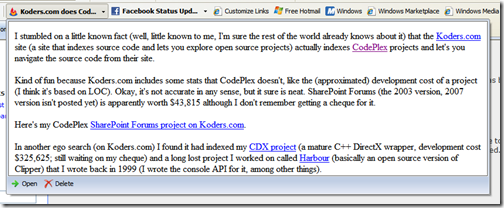
This is a pretty boring slice. Here's my web slice from my Facebook Friends update which is a little sexier:
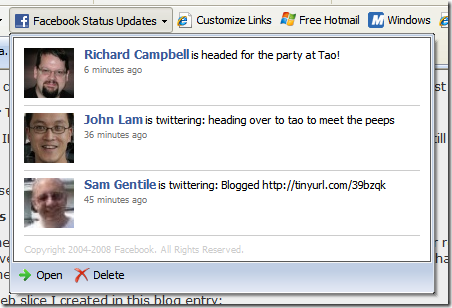
My issues with Web Slices
These are just my issues, and might be very well unfounded since I've only been playing with this specific feature for all of 10 minutes so YMMV.
IE8 is *supposed* to be W3C compliant (by default, you can turn it off via an option). This means that a) most old sites that were built to "work" in IE7 with IE hacks and workarounds, might not render properly in IE8 and b) IE8 is compliant to a standard not set or dictated by Microsoft (although they are on the committee).
So I'm confused.
A new compliant browser yet they're now introducing this "feature" called Web Slices that requires you to markup your system using specific codes. Grant you, when you look at the code to create a web slice (below) it's minimal and isn't non-compliant but to me something just seems funny here. Here's the code you need to implement a web slice:
<div class="hslice" id="1"> <p class="entry-title">Game System - $66.00</p> <div class="entry-content"> <img src="game.jpg"> <p>End time: <abbr class="endtime" title="2008-02-28T12:00:00-05:00"> 6 hours</abbr></p> </div> <a rel="feedurl" href="www.ebay.com/game.xml">Subscribe to Feed</a> <p>This item updates every <span class="ttl">15</span> minutes.</p> </p> </div>
Also this is my first exposure to something called hAtom Microformat (which by the way doesn't navigate properly with IE8, can't page up/down on the site) so it's interesting that you specific fixed name classes (entry-title, entry-content, etc.) to tag content. IE8 Web Slices builds on this and adds it's own "hslice" tag to the mix.
So I can tag content this way, but now I'm going to have to be very careful when I design my CSS to not override these classes (no idea what havok we'll wroth if we change the "hslice" class, perhaps the universe will open up and we'll all be whisked away to a land of lean naked bodies on the shores of an endless river?).
In any case, watch for these web slices to show up soon. Not sure how much this is going to catch on, we're already in information overload with email, RSS feeds, newsgroups, mailing lists, etc. Is another notification mechanism something the world needs now? Are web slices going to give me anything more than what I already get with RSS (except maybe the mechanism to subscribe, which can be pretty easy with RSS now anyways).
Domain Names
When browsing a website you'll see in the address bar the domain name of the site you're browsing highlighted. Everything else is grayed out.
![]()
This filters out any subdomains and all the other stuff that I suppose you don't need to know. Guess this is to help people know they're on a site that's about to steal their identity and credit card info and run off to Bora Bora (well, that's what *I* would do).
Problems
Of course there are issues with this release. It is beta 1 after all so don't expect wine and roses. For example, I had to turn off my Google toolbar to even read the Web Slices Specification Format page on MSDN. It kept crashing the browser.
I think the biggest problem with the release is that there are rendering issues, rendering issues, and more rendering issues. You would think by version 8 rendering out an interpretation of a bunch of codes with angle brackets would be understood by now. Guess not.
For example the new Code Gallery site doesn't quite render properly in IE8,
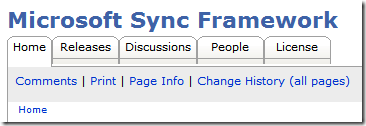
neither does weblogs.asp.net:

neither does CodePlex (another site Google toolbar + IE8 = crash),

neither does SourceForge,
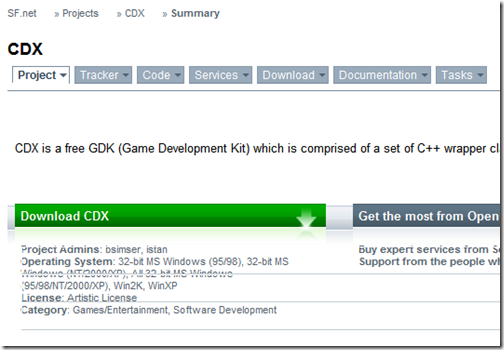
neither does CodeBetter (holy ugly step sister batman!)
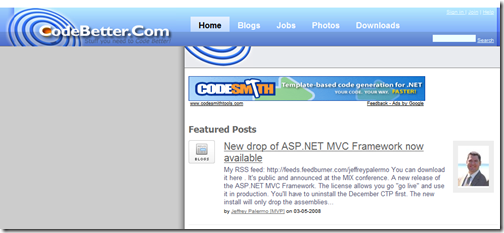
neither does this blog.
Rendering is a problem which is a result of Internet Explorer being a victim of it's own success. So many websites coded in hacks and workarounds and fixes to "get around" buggy rendering IE5, IE6, etc. and now comes along IE8 to fix the problem and render things correctly. Problem is all those sites (and there are a lot) may not have the manpower to go back and unfix their bugs (or whatever the term is as I'm all bass ackwards).
Am I being too hard? After all it *is* beta 1 after all. I feel a product like Internet Explorer is mature enough that things like rendering pages should be second nature by now. Software that matters. For a web browser, I think the only thing that really matters is "can I view a web page as it was designed?". Apparently not yet.
Oh well, at least we can always rely on Jakob Nielsen.
I stumbled on a little known fact (well, little known to me, I'm sure the rest of the world already knows about it) that the Koders.com site (a site that indexes source code and lets you explore open source projects) actually indexes CodePlex projects and let's you navigate the source code from their site.
Kind of fun because Koders.com includes some stats that CodePlex doesn't, like the (approximated) development cost of a project (I think it's based on LOC). Okay, it's not accurate in any sense, but it sure is neat. SharePoint Forums (the 2003 version, 2007 version isn't posted yet) is apparently worth $43,815 although I don't remember getting a cheque for it.
Here's my CodePlex SharePoint Forums project on Koders.com.
In another ego search (on Koders.com) I found it had indexed my CDX project (a mature C++ DirectX wrapper, development cost $325,625; still waiting on my cheque) and a long lost project I worked on called Harbour (basically an open source version of Clipper) that I wrote back in 1999 (I wrote the console API for it, among other things).
Amazing crap you discover on the net some days...
 The Moth, aka Daniel Moth, a former MVP and now Microsoft UK dude posted a blog entry The ABCDEFGHI of setting up Visual Studio for Demos. In it he makes some good points about setting up Visual Studio when you're on the road to present. I totally agree with him on look and feel. I still use a white-on-black theme (a modified version of Jeff Attwoods look and feel) for my own day to day development because at 1600x1200 IJW. When I'm presenting though I flip over to a secondary computer account (called DemoBoy) that has all the settings for the colours and themes in Visual Studio set to default (along with a toned down desktop, bigger fonts, etc.). The font size in the IDE is set at Consolas 14 (imagine coding at that all the time) and I favour using ZoomIt for zooming in on code as it lets me do markup and such which is mucho better than changing font size (although you can get the VS Power Toys which has a font mouse wheel scroller in it).
The Moth, aka Daniel Moth, a former MVP and now Microsoft UK dude posted a blog entry The ABCDEFGHI of setting up Visual Studio for Demos. In it he makes some good points about setting up Visual Studio when you're on the road to present. I totally agree with him on look and feel. I still use a white-on-black theme (a modified version of Jeff Attwoods look and feel) for my own day to day development because at 1600x1200 IJW. When I'm presenting though I flip over to a secondary computer account (called DemoBoy) that has all the settings for the colours and themes in Visual Studio set to default (along with a toned down desktop, bigger fonts, etc.). The font size in the IDE is set at Consolas 14 (imagine coding at that all the time) and I favour using ZoomIt for zooming in on code as it lets me do markup and such which is mucho better than changing font size (although you can get the VS Power Toys which has a font mouse wheel scroller in it).
However I was taken aback from his point on leaving the 3rd party addins at home. I'm a ReSharper and keyboard junkie and won't work without my R#. I stumble through Visual Studio when it's not installed or activated, hitting all kinds of crazy keystrokes that get me nowhere. Now grant you, when you're on the demo scene (either live or screencasting) 9 times out of 10 I've been asked "What's that little red/green thing on the side" or "How did you create that class so quickly?"
So it's a toss up. I'm guilty of using R# in my IDE but can't fathom not using it, even for demos. I mean, I'm going to stumble through a demo looking pretty silly when I pound on my keyboard hitting Ctrl+N and not getting the list I expect. It's unnatural to me. Like not writing unit tests.
Are you presenting code somewhere? Do you suffer from the same fate as I? Do you suck it up and learn the dreaded default Visual Studio keystrokes or do you factor in the interruption you're going to get explaining R# to someone. What say you peeps? R# or no, when it comes to presenting?
Registration for the ALT.NET event in Seattle (April 18-20) is closed so if you register you'll get put onto the waiting list (there are only a few people on it right now). However the participant list is simply amazing. It's like the who's who of the Agile software development world.
Phil Haack, Tom Opgenorth, Craig Beck, Kevin Hegg, Miguel Angel Saez, Dustin Campbell, Justin-Josef Angel, David Pokluda, Carlin Pohl, Matthew Podwysocki, Adam Dymitruk, Wendy Friedlander, Oliver, Chris Bilson, Jeff Certain, Dave Foley, Joe Pruitt, Jeff Tucker, Jeffrey Palermo, Anil Verma, Greg Banister, Chris Salahub, Jesse Johnston, Robert Ream, Jim Hugunin, Chantal Laplante, Owen Rogers, Mike Stockdale, Cameron Frederick, Dan Miser, Greg Sangha, Joey Beninghove, Jean-Paul S. Boodhoo, Ben Scheirman, D'Arcy Lussier, Chris Patterson, Ronald S Woan, Rob Reynolds, Adam Tybor, Eric Holton, Scott Hanselman, Gabriel Schenker, Wade Hatler, Arvind Palaniswamy, Weston Binford, Jonathan de Halleux, Joseph Hill, Matt Hinze, Dave Laribee, Nick Parker, Ray Houston, Steven "Doc" List, Jason Grundy, Brian Donahue, John Quach, Alex Hung, James Thigpen, Chris Sutton, Ian Cooper, Rajbeer Dhatt, John Teague, Eli Lopian, Eric Ness, Scott Allen, Aaron Jensen, Rustan Leino, Bil Simser, Rob Zelt, Jeff Brown, Phil Dennis, Tom Dean, Tim Barcz, Sean Solbak, David Pehrson, James Franco, Bryce Budd, Scott Guthrie, Jay Flowers, david p buchanan, Howard Dierking, David Airth, Jonathan Wanagel, Matt Pisut, Julie Poole, Jarod Ferguson, Jacob Lewallen, Rhys Campbell, Joe Ocampo, Brad Abrams, Russell Ball, Michael Bradley, Bertrand Le Roy, Simon Guest, Alvin Lee, khalil El haitami, Roy Osherove, Scott Koon, Charlie Poole, Pete McKinstry, Sergio Pereira, Brad Wilson, Piriya Thongtanunam, Neil Blake, Brian Henderson, Martin Salias, Grant Carpenter, Colin Jack, James Shore, Kirk Jackson, Rod Paddock, Alan Buck, John Nuechterlein, Rajiv Das, Jeremy D. Miller, Chris Ortman, Robert Smith, Kelly Leahy, Chris Sells, Dru Sellers, Robin Clowers, Terry Hughes, Ashwin ParthasarathyOsidosi, Drew Miller, Dennis Olano, Anand Raju Narayan, Glenn Block, Brandon Lang, Pete Coupland, Trevor Redfern, Ward Cunningham, Troy Gould, Don Demsak, Neil Bourgeois, John Lam, Donald Belcham, Phil MCmillan, Udi Dahan, Martin Fowler, James Kovacs, Ayende Rahien, Danieljakob Homan, Raymond Lewallen, Jeff Olson, Justice Gray, Douglas Schroeder, Justin Bozonier, Luke Foust, Michael Henderson, Shawn Wildermuth, Dave Woods, Chad Myers, Shane Bauer, Michael Nelson, Kyle Baley, Buchanan Dunn, Scott C Reynolds, Greg Young.
I wish I had a tag cloud for the names or something as so many people have so much influence on ALT.NET practices today. It's going to be an awesome get together!
I found it rather funny (thanks Jenn!) having a conference named after me. Well, not exactly named *after* me, but when you're basically the only guy on the planet who spells his name "BIL" you have to laugh when you see this.

Best of all is the description of What is BIL? (something I always ponder myself each morning as I head into work).
"BIL is to TED, what BarCamp is to FooCamp".
We should probably break down and tell TED this at some point.
Andrew Connell wrote an excellent blog entry on building your WSS solution packages with MSBuild. My problem is that I can't stand MSBuild and find it crazy complicated for even the simplest of tasks. Andrew's post possibly led to the creation (or at least contribution) of STSDEV, a very interesting value-added tool by Ted Pattison and co. that helps ease the pain of building SharePoint solutions. However I found it has it's issues and doesn't really work the way I like to (for example I don't like having everything in one single assembly).
My choice of build tool these days is NAnt (although I'm starting to look at something like Rake or even Boo to make building easier using a DSL) and I find it easier (in my feeble brain anyway) to build and deploy SharePoint solutions with NAnt. I've blogged about it before, but that was v2.0 and here we are in 2008 with new shiny happy solution packages. So here we go.
First we'll start with a basic NAnt build script. When I start a project I create it and set a default target of "help" then in that describe the targets you can run. This provides some documentation on the build process and let's me get a build file up and running.
<?xml version="1.0" encoding="utf-8"?>
<project name="SharePointForums" default="help">
<target name="help">
<echo message="--------------------" />
<echo message="targets in this file" />
<echo message="--------------------" />
<echo message="help - display targets in the nant script. This is the default target." />
<echo message="clean - cleans up the temporary directories" />
<echo message="init - sets up the temporary directories" />
<echo message="compile - compiles the solution assemblies" />
<echo message="test - compiles the solution assemblies then runs unit tests" />
<echo message="build - builds the entire solution for packaging/installation/distribution" />
<echo message="dist - creates a distribution zip file containing solution installer, wsp, and config files" />
<echo message="---------------------------" />
<echo message="targets in SharePoint.build" />
<echo message="---------------------------" />
<echo message="addsolution - installs the solution on the SharePoint server making it avaialble for deployment" />
<echo message="deploysolution - deploy the solution to the local server for the first time" />
<echo message="retractsolution - removes the deployed solution from the local server" />
<echo message="deletesolution - removes the solution from the server completely. calls retractsolution first" />
</target>
</project>
In fact, at this point I can check this into CruiseControl.NET and it'll build successfully.
Doesn't do much at this point, but it's our roadmap. You'll notice there are a few targets listed in a file called SharePoint.build. I've found that these are typical and never change, you just change the properties of the filenames they act on. Let's take a look at this file:
<?xml version="1.0" encoding="utf-8"?>
<project name="SharePoint">
<!-- directory and file names, generally won't change -->
<property name="build.dir" value="${root.dir}\build" />
<property name="solution.dir" value="${source.dir}\solution" />
<property name="deploymentfiles.dir" value="${solution.dir}\DeploymentFiles" />
<property name="tools.dir" value="${root.dir}\tools" />
<!-- executable files that shouldn't change -->
<property name="makecab.exe" value="${tools.dir}\makecab\makecab.exe" />
<property name="stsadm.exe" value="${tools.dir}\stsadm\stsadm.exe" />
<target name="buildsolutionfile">
<exec program="${makecab.exe}" workingdir="${solution.dir}">
<arg value="/F" />
<arg value="${deploymentfiles.dir}\${directives.file}" />
<arg value="/D" />
<arg value="CabinetNameTemplate=${package.file}" />
</exec>
<move
file="${deploymentfiles.dir}\${package.file}"
tofile="${build.dir}\${package.file}" />
</target>
<!-- stsadm targets for deployment -->
<target name="addsolution">
<exec program="${stsadm.exe}" verbose="${verbose}">
<arg value="-o" />
<arg value="addsolution" />
<arg value="-filename" />
<arg value="${build.dir}\${package.file}" />
</exec>
<call target="spwait" />
</target>
<target name="spwait" description="Waits for the timer job to complete.">
<exec program="${stsadm.exe}" verbose="${verbose}">
<arg value="-o" />
<arg value="execadmsvcjobs" />
</exec>
</target>
<target name="deploysolution" depends="addsolution">
<exec program="${stsadm.exe}" workingdir="${build.dir}" verbose="${verbose}">
<arg value="-o" />
<arg value="deploysolution" />
<arg value="-name" />
<arg value="${package.file}" />
<arg value="-immediate" />
<arg value="-allowgacdeployment" />
<arg value="-allcontenturls" />
<arg value="-force" />
</exec>
<call target="spwait" />
</target>
<target name="retractsolution">
<exec program="${stsadm.exe}" verbose="${verbose}">
<arg value="-o" />
<arg value="retractsolution" />
<arg value="-name" />
<arg value="${package.file}" />
<arg value="-immediate" />
<arg value="-allcontenturls" />
</exec>
<call target="spwait" />
</target>
<target name="deletesolution" depends="retractsolution">
<exec program="${stsadm.exe}" verbose="${verbose}">
<arg value="-o" />
<arg value="deletesolution" />
<arg value="-name" />
<arg value="${package.file}" />
</exec>
<call target="spwait" />
</target>
</project>
This file contains a few targets for directly installing and deploying solutions into SharePoint (using stsadm.exe). It simply calls makecab.exe or stsadm.exe (which are local to the project in a tools directory) and executes them with the appropriate filenames. The filenames are set as properties in your main build file, then that build file includes this one. This SharePoint.build file generally never has to change and you can use it from project to project.
You might notice a "DeploymentFiles" folder used as the "deploymentfiles.dir" property. This is taking a queue from STSDEV, using it as a root folder in the solution where the *.ddf and manifest.xml file live for the solution. There's also a RootFiles folder which contains various subfolders with the webparts, features, images, resources, etc. in it. Here's a look at the development tree:

All source code that will be compiled into assemblies lives under "src". The "solution" folder is the root folder where DeploymentFiles and RootFiles lives as I consider things like feature and site defintions to be part of the solution and source code, just like say a SQL script. Under "src" I have "app" which contains the web parts, feature receivers, etc. and "test" which contains unit test assemblies. This allows you (as you'll see) to build each independently as I don't want my unit test code mixing up with my web parts or domain code. Under "src" they'll be many projects, but in the build file we collapse them all down to one assembly for testing purposes.
The "lib" folder contains external assemblies I reference (but not necessarily deploy) in the solution. This actually contains a copy of SharePoint.dll and SharePoint.Search.dll. You might wonder why I have copies of the files here while they exist in the GAC or buried in the 12 hive. It's because I prefer to have my solution trees to be self-contained. Anyone can grab this entire tree, no matter what version of what they have installed and build it (that includes the tools folder with all the tools they need to build it).
In the "tools" folder I have a copy of stsadm.exe (again, if the version changes on the server I'm protected and using the version I need), NAnt (for the build itself), makecab.exe to create the .wsp file and SharePoint Solution Installer, a really cool tool that runs against my WSP and lets you install and configure it without having to write an installer. You just edit a .config file and provide it the .wsp file.
Back to our project.build file. We'll setup some properties that will get used both in our build file and the SharePoint.build one (like the root directory where things are, etc.)
<!-- global properties, generally won't change -->
<property name="nant.settings.currentframework" value="net-2.0" />
<!-- filenames and directories, generally won't change -->
<property name="root.dir" value="${directory::get-current-directory()}" />
<property name="source.dir" value="${root.dir}\src" />
<property name="directives.file" value="${project::get-name()}.ddf" />
<property name="package.file" value="${project::get-name()}.wsp" />
<property name="dist.dir" value="${root.dir}\dist" />
<property name="lib.dir" value="${root.dir}\lib" />
<!-- properties that change from project to project but not often -->
<property name="webpart.source.dir" value="${source.dir}\app\SharePointForums.FeatureReceiver" />
<property name="feature.source.dir" value="${source.dir}\app\SharePointForums.WebParts" />
<property name="test.source.dir" value="${source.dir}\test" />
<property name="webpart.lib" value="${project::get-name()}.WebParts.dll" />
<property name="feature.lib" value="${project::get-name()}.Feature.dll" />
<property name="test.lib" value="${project::get-name()}.Test.dll" />
<!-- "typical" properties that change -->
<property name="version" value="2.0.0.0" />
<property name="debug" value="true" />
<property name="verbose" value="false" />
Then we'll include our SharePoint.build file:
<!-- include common SharePoint targets -->
<include buildfile="SharePoint.build" />
Recently I've switched to using patternsets inside of filesets in NAnt as it's more flexible. So we'll define a patternset for source files and assemblies, then use this in our filesets for the webpart, feature, and test sources and assembly files.
<!-- filesets and pattern sets for use instead of naming files in targets -->
<patternset id="cs.sources">
<include name="**/*.cs" />
</patternset>
<patternset id="lib.sources">
<include name="**/*.dll" />
</patternset>
<fileset id="feature.sources" basedir="${feature.source.dir}">
<patternset refid="cs.sources" />
</fileset>
<fileset id="webpart.sources" basedir="${webpart.source.dir}">
<patternset refid="cs.sources" />
</fileset>
<fileset id="test.sources" basedir="${test.source.dir}">
<patternset refid="cs.sources" />
</fileset>
<fileset id="sharepoint.assemblies" basedir="${lib.dir}">
<patternset refid="lib.sources" />
</fileset>
<fileset id="solution.assemblies" basedir="${build.dir}">
<patternset refid="lib.sources" />
</fileset>
Finally here are the targets in our project build file.
Clean will just remove any temporary directories we built:
<target name="clean">
<delete dir="${build.dir}" />
<delete dir="${dist.dir}" />
</target>
Init will first call clean, then create the directories:
<target name="init" depends="clean">
<mkdir dir="${build.dir}" />
<mkdir dir="${dist.dir}" />
</target>
Compile will call init, then using the <csc> task, build our sources into assemblies. We're using a strongly named keyfile so we specify this in our csc task (otherwise when we deploy we'll get warnings about unsigned assembies, feature receivers must be put into the GAC and require signing).
<target name="compile" depends="init">
<csc output="${build.dir}\${feature.lib}" target="library" keyfile="${project::get-name()}.snk" debug="${debug}">
<sources refid="feature.sources" />
<references refid="sharepoint.assemblies" />
</csc>
<csc output="${build.dir}\${webpart.lib}" target="library" keyfile="${project::get-name()}.snk" debug="${debug}">
<sources refid="webpart.sources" />
<references refid="sharepoint.assemblies" />
</csc>
</target>
Test first calls compile to get all the web part, feature, and domain assemblies built then compiles the unit test assembly. Finally it will call our unit test runner (MbUnit.Cons.exe or whatever). The output of the unit test run can be used in a CI tool like CruiseControl.NET.
<target name="test" depends="compile">
<csc output="${build.dir}\${test.lib}" target="library" debug="${debug}">
<sources refid="test.sources" />
<references refid="sharepoint.assemblies" />
<references refid="solution.assemblies" />
</csc>
<!-- run unit tests with test runner (mbunit, nunit, etc.) -->
</target>
Our "build" task just calls test (to ensure everything compiles and works) then delegates to the SharePoint.build file to build the solution. This will create our .wsp file and put us in a position to deploy our solution.
<target name="build" depends="test">
<call target="buildsolutionfile" />
</target>
Finally in this build file we have a dist task. This will build the entire solution then zip up the Solution Installer files and wsp file into a zip file that we'll distribute. End users just download this, unzip it, and run Setup.exe to install the solution.
<target name="dist" depends="build">
<zip zipfile="${dist.dir}\${project::get-name()}-${version}.zip">
<fileset basedir="${build.dir}">
<include name="**\*.wsp" />
</fileset>
<fileset basedir="${tools.dir}\SharePointSolutionInstaller">
<include name="**\*" />
</fileset>
</zip>
</target>
There's a lot of NAnt script here, but it's all pretty basic stuff. The nice thing is that from the command line I can build my system, install it locally, deploy it for testing, and event create my distribution for release on CodePlex (or whatever site you use). There's a go.bat file that lives in the root of the solution and looks like this:
@echo off
tools\nant\nant.exe -buildfile:SharePointForums.build %*
It simply calls NAnt with the buildfile name and passes any parameters to the build. For example from the command line here's the output of "go build deploysolution" which will compile my system, run all the unit tests, then add the solution to SharePoint and deploy it. After this I can simply browse to my website and do some integration testing.
NAnt 0.86 (Build 0.86.2898.0; beta1; 12/8/2007)
Copyright (C) 2001-2007 Gerry Shaw
http://nant.sourceforge.net
Buildfile: file:///C:/Development/Forums/SharePointForums.build
Target framework: Microsoft .NET Framework 2.0
Target(s) specified: build deploysolution
clean:
[delete] Deleting directory 'C:\Development\Forums\build'.
[delete] Deleting directory 'C:\Development\Forums\dist'.
init:
[mkdir] Creating directory 'C:\Development\Forums\build'.
[mkdir] Creating directory 'C:\Development\Forums\dist'.
compile:
[csc] Compiling 22 files to 'C:\Development\Forums\build\SharePointForums.Feature.dll'.
[csc] Compiling 182 files to 'C:\Development\Forums\build\SharePointForums.WebParts.dll'.
test:
[csc] Compiling 41 files to 'C:\Development\Forums\build\SharePointForums.Test.dll'.
build:
buildsolutionfile:
[exec] Microsoft (R) Cabinet Maker - Version (32) 1.00.0601 (03/18/97)
[exec] Copyright (c) Microsoft Corp 1993-1997. All rights reserved.
[exec]
[exec] Parsing directives
[exec] Parsing directives (C:\Development\Forums\src\solution\DeploymentFiles\SharePointForums.ddf: 1 lines)
[exec] 140,309 bytes in 7 files
[exec] Executing directives
[exec] 0.00% - manifest.xml (1 of 7)
[exec] 0.00% - SharePointForums.Feature.dll (2 of 7)
[exec] 0.00% - SharePointForums.WebParts.dll (3 of 7)
[exec] 0.00% - SharePointForums\Feature.xml (4 of 7)
[exec] 0.00% - SharePointForums\WebParts.xml (5 of 7)
[exec] 0.00% - SharePointForums\WebParts\SharePointForums.webpart (6 of 7)
[exec] 0.00% - IMAGES\SharePointForums\SharePointForums32.gif (7 of 7)
[exec] 100.00% - IMAGES\SharePointForums\SharePointForums32.gif (7 of 7)
[exec] 0.00% [flushing current folder]
[exec] 93.59% [flushing current folder]
[exec] 5.60% [flushing current folder]
[exec] 100.00% [flushing current folder]
[exec] Total files: 7
[exec] Bytes before: 140,309
[exec] Bytes after: 50,736
[exec] After/Before: 40.09% compression
[exec] Time: 0.04 seconds ( 0 hr 0 min 0.04 sec)
[exec] Throughput: 349.34 Kb/second
[move] 1 files moved.
addsolution:
[exec]
[exec] Operation completed successfully.
[exec]
spwait:
[exec]
[exec] Operation completed successfully.
[exec]
deploysolution:
[exec]
[exec] Timer job successfully created.
[exec]
spwait:
[exec]
[exec] Executing solution-deployment-sharepointforums.wsp-0.
[exec] Operation completed successfully.
[exec]
BUILD SUCCEEDED
Total time: 22.2 seconds.
Hope this helps your build process. Creating SharePoint solutions is a complicated matter. There are features, web parts, solutions, manifests, various tools, and lots of command line tools to make it all go. NAnt helps you tackle this and these scripts boil the solution down to only a few simple commands you need to remember.
One of the cool features in SharePoint 2007 are Feature Event Classes. These classes allow you to trap and respond to an event that fires when a feature is installed, activated, deactived, or removed. While you can't cancel an installation or activation through the events, you can use them to your advantage to manipulate the scoped item they're operating on.
In my SharePoint Forums Web Part, I had delegated the creation of the lists to the web part itself whenever it was added to a site. Of course I didn't go farther and clean up the lists the web part created when it was removed because there was no way to tell when someone removed a web part from a page (since it might not be the only one on the page). This has led to various problems (users had to be server admins to make this work 100% of the time, lists left over from old installs) but in the 2007 version Feature Event Recievers come to the rescue. Now when you activate the Forums on a web, it creates the needed lists and when you deactivate it the receiver removes them. You create a Feature Reciever by inheriting from the base class of SPFeatureReceiver. In it there are 4 methods you can override (activating, deactivating, installing, uninstalling).
One thing you don't have is a Context object so it makes it a little tricky to get the SPSite/SPWeb object the feature is activating on. Luckily there's a nice property (of type object) in the SPFeatureReceiverProperites object that gets passed to each method. This class contains a property class Feature which in turn contains a property called Parent. The Parent property is the scoped item that is working against the feature so if you scope your feature to Web, you'll get a SPWeb object (Site for an SPSite object, etc.). This is the key in getting a hold of and manipulating your farm/server/site/web when a feature is accessed.
Here's an example of a feature. When the feature is activated, it creates a new list. When it's deactivated it removes the list.
public class FeatureReceiver : SPFeatureReceiver
{public override void FeatureActivated(SPFeatureReceiverProperties properties)
{ using (SPWeb web = (SPWeb) properties.Feature.Parent) {web.Lists.Add("test", "test", SPListTemplateType.GenericList);
}
}
public override void FeatureDeactivating(SPFeatureReceiverProperties properties)
{ using (SPWeb web = (SPWeb) properties.Feature.Parent) { SPList list = web.Lists["test"];web.Lists.Delete(list.ID);
}
}
public override void FeatureInstalled(SPFeatureReceiverProperties properties)
{ /* no op */}
public override void FeatureUninstalling(SPFeatureReceiverProperties properties)
{ /* no op */}
}
BTW, it's not clear to me if getting an SPWeb object through this means requires the disposing of it. See Scott Harris and Mike Ammerlaans excellent must-read article here on scoped items which might help. For me, this is the safest approch (the object will always fall out of scope and dispose of itself). It might be overkill but it works. Feature receivers are not the easiest things to debug.
Enjoy!
 WPF is all the rage (at least that's what they tell me) and it's IMHO one of the best technologies to come out of Microsoft. Still, however, companies choose to stay the course with building on WinForms. Karl Shifflett has a great blog entry on choosing WPF over ASP.NET (and great entries on WPF in general so check his blog out here). To me it's a no-brainer choosing WPF over ASP.NET, unless you're really enamored with a browser app (or forced to build one due to some constraints) and with Silverlight and XBAP (and the new features coming out shortly in Silverlight 2) building a rich interface for the web gets better and better. AJAX just doesn't cut it and is a hack IMHO.
WPF is all the rage (at least that's what they tell me) and it's IMHO one of the best technologies to come out of Microsoft. Still, however, companies choose to stay the course with building on WinForms. Karl Shifflett has a great blog entry on choosing WPF over ASP.NET (and great entries on WPF in general so check his blog out here). To me it's a no-brainer choosing WPF over ASP.NET, unless you're really enamored with a browser app (or forced to build one due to some constraints) and with Silverlight and XBAP (and the new features coming out shortly in Silverlight 2) building a rich interface for the web gets better and better. AJAX just doesn't cut it and is a hack IMHO.
Making the decision between WPF and WinForms however is a different story. Sure, WPF is the new hotness and WinForms is old and busted but is it the right choice? Obviously "it depends" on the situation and Microsoft is continuing to deliver and support WinForms so it won't be going away anytime soon. So what are the compelling factors to choose WPF over WinForms? Karl hints at choices of WPF over WinForms in his WPF Business Application series, but the reasons might be subtle for some.
If you're struggling here are some reasons for choosing WPF over WinForms, and let's play devils advocate as you might have to fight for some of these.
Latest Technology
Why start new development on old technologies? There's bleeding edge (Silverlight 2 perhaps) and then there's cutting edge (WPF?) and we can probably start to talk about WinForms as legacy. Start, not come to that conclusion. WinForms development can be painful (much like moose bites) but the latest technology debate is a tough one. One on hand it's lickety-split to create WPF using the tools available today (see below) and from a development perspective WPF shines because everything is an object. The crazy hoops you have to jump through just to get an image on a button or menu are all but gone when you try embedding an object onto another one in XAML. On the flipside though, most of the large UI suites (DevExpress, Infragistics, Component One, Telerik) haven't fully completed their WPF implementations and the maturity lies in their WinForm incantations. Still, starting a new project today that might be delivered say 6-12 months from now doesn't make a lot of sense building on what some might consider legacy but as usual, you have to pick the right tool for the right job.
Mature Product
While WPF is pretty young in the eyes of consumers, Microsoft has invested 5+ years of development in it. WinForms arguably has the edge on maturity here (existing since the .NET 1.0 days) but don't knock WPF as a babe in the woods. It popped up on the R&D radar back in shortly after .NET 1.1 and Visual Studio 2003 came out and has been gestating ever since. This is a plus point if you're in a boardroom or meeting with some stuffies who think it's new and shiny but with no meat behind it. Combined with its own set of unique features, try something like UI automation and WinForms and we'll talk maturity. 10 years after WinForms was born and we're still struggling with UI automation. WPF solves this in one fell swoop, and does a nice job of it to boot.
Silverlight
WPF is based on XAML for it's definitions (both application code and UI design). Silverlight is the same because after all crunching down and serializing XML is dead simple these days. While Silverlight uses a subset of WPF for it's rendering, you can re-use a lot of what you might create in WPF and your application. This makes for building multiple UIs a happy-happy-joy-joy scenario. Too many times I've been faced with the problem of building a system for web users *and* desktop users. Too many times we've had to dumb down the web because it couldn't handle the rich experience the desktop provides, or be faced with 100k of JavaScript (yeah, try debugging that mess after a few sleepless nights) so anything has to be better than this. Silverlight lets you leverage a lot of your XAML investment you make in a WPF app and with technologies like BAML you can push the envelope even further. It's a win-win scenario for everyone and lays the smack down on Flash or Java anyday.
Tools
While we live in a domain driven design world (at least some of us do, you have come out of your cave right?) with objects and collections and tests oh my, there is still the UI to design. I'm not a huge fan of the move to CSS validated Expression Web, but I understand (and agree with) the choices Microsoft made with the model. Kicking it up a notch and delivering Expression Blend with it's integration into Visual Studio makes building WPF apps a breeze. In fact, I strongly advocate and support handing the UI design off to someone better suited to it. Let's face it, developers suck the big one at building UIs (unless it's "Hello World" with a big button and an image of Scott Hanselmans face on it) so let's let the UI designers design. Blend lets you do this by just letting the designers "go wild" as it were, without having to worry about "how in the heck am I going to hook this up later". Giving a designer a copy of Visual Studio to design a WinForm app is just plain crazy, and don't even try to convert their JPG mockups that have been signed off on into a Windows Form (been there, more t-shirts, I have a lot of them) but getting a XAML file from them just plugs right into our development environment and is dead simple to wire up to whatever back-end you have going at the time.
UI Resolution
How many bugs do you have logged on your current project that say something like "cannot see button x when my screen resolution is 800x600"? As a developer, we generally work at crazy resolutions that no sane person would run at (my current desktop runs at 1680x1050) so building forms on this just plain doesn't translate well (read: at all) to a users desktop of 800x600 or 1024x768. Buttons vanish, menu options disappear, and that oh so beautiful grid that is the lynchpin of your appplication is missing the bottom 20 rows and last 10 columns. Sure, WinForm containers and whatnot help but far too many times we forget about this and end up building things off in unseen areas of the screen. WPF doesn't solve this problem, but really helps. Not only that, we're not asking users to change the resolution or font size on their screen to see things clearly. In this day and age, users need to be able to dynamically change the system at will when they're working. I've seen users running with the extra large font theme as their eyes give out on them but apps just plain don't work well when your system font is 36pt Verdana. Look at the iPhone as an example of clever UI integration. It dynamically zooms in and out as you choose to make things readable. We need more of this on the desktop applications we build to suite the needs of users who want "to see it all" at once. WPF let's us do this with less pain than WinForms.
Databinding
WPF allows for much easier data binding through its model and this can result in faster development time. Now Unka Bil isn't telling you to go out and bind your WPF creations directly to ADO.NET models. I still live and die by Domain Driven Design so binding happens on objects (probably best through a Binding<T> adapter of your domain classes) but WPF does make it easier to do this if that's your thang.
So overall it's a better experience, both from the development side and consumer side. Again, you might have some battles to fight with Corporate to jump onto the technology band-wagon, but this is might be a battle worth fighting for. WPF is no silver bullet (as I always harp, the is no silver bullet unless you're fighting werewolves) but hopefully this will help you make a more informed choice. The choice is yours, but choose wisely.
 First off let me start the disclaimer. I do not work for Microsoft and have no decision making powers in anything that goes into a piece of software. You might call me an "influencer" as we MVPs may suggest things at times (sometimes very verbally) but we don't take a laundry list to Microsoft and make demands of new features. Keep that in mind while you read this post.
First off let me start the disclaimer. I do not work for Microsoft and have no decision making powers in anything that goes into a piece of software. You might call me an "influencer" as we MVPs may suggest things at times (sometimes very verbally) but we don't take a laundry list to Microsoft and make demands of new features. Keep that in mind while you read this post.
One of the biggest complaints a lot of us hear about SharePoint development is the need to build on Windows 2003 server. I still to this day have no idea what the critical dependency on Windows 2003 Server is, but obviously there must be one. Otherwise we would be building solutions on XP and Vista. As an ASP.NET developer, we have a local IIS (5.1) instance available to us for development and with VS2005 there's even a built-in web server for building websites. So forcing developers to use a server for SharePoint development can seem a little harsh, hence all the complaints.
Working on a real server (say a development one in your network) is a no-go, unless you're the only developer on the machine. You just can't do things like hang the worker process or force a iisreset for other developers. That's just not cool. And from a SharePoint perspective, you'll be clobbering each other all the time if you're on a shared server (been there, done that, got the t-shirt).
That leaves virtual development (using either Virtual PC, Virtual Server, or VMWare). This is probably the best choice but it's costly. Setting up the VM requires a significant time investment to get all your ducks in a row, even more if you want to keep this long term so you're going to have to create some parent-child relationships on VM hierarchies (see AC's post here about this).
Hardware *is* cheap but in the corporate world it's not always cheap that wins. Trying to get network services convinced you're not going to bring down their network with your little VM isn't easy (more t-shirts) and you'll battle issues of software updates, virus protection, licensing, and a host of others. It's a hard battle, but perhaps one worth fighting.
The MVP community is a little splintered on whether or not a Developer Version of SharePoint would be value-add (BizTalk has one, so why not SharePoint?). Some think it's necessary, others would rather have MS focus their efforts elsewhere and live with VM development. Microsoft is listening and going over ideas and approaches to ease the pain here but nothing to tell you from the trenches right now.
So what say you? Would you want a Developer Edition of SharePoint (maybe only WSS so no Excel/InfoPath/BDC services that MOSS offers) that you could install on XP/Vista to local development? Should the efforts be focused on making the Virtual Experience better? Or does none of this matter and all is rosy in the world when it comes to building SharePoint solutions?
Feel free to chime in here. Like I said, I'm not guarantying this is going to get back to Microsoft but some people read my blog (or so they tell me) so you never know.
 A co-worker turned me onto Project White, an automated UI testing framework by ThoughtWorks. This along the same lines as NUnitForms and other automated systems. It's basically Selenium for WinForms (which rocks in its own right) so I thought I would dig more into White (it has support for WPF as well, but I haven't tried that out yet). It was good timing as we've been talking and coming up with strategies for testing and UI testing is a big problem (and it is everywhere else based on people I've talked to).
A co-worker turned me onto Project White, an automated UI testing framework by ThoughtWorks. This along the same lines as NUnitForms and other automated systems. It's basically Selenium for WinForms (which rocks in its own right) so I thought I would dig more into White (it has support for WPF as well, but I haven't tried that out yet). It was good timing as we've been talking and coming up with strategies for testing and UI testing is a big problem (and it is everywhere else based on people I've talked to).
The White library is nice and simple. All you really need to do is add in the Core.dll from White and your unit test framework and write some tests. I tested it with MbUnit but any framework seems to work. Ben Hall posted a blog entry about White along with some sample code. This, combined with the library got me started.
As Ben did, I created a simple application with a single form and started to write some tests. I couldn't use Ben's complete sample as it was written for VS2008 and I only had VS2005 for my testing. No problem. You can use White with VS2005, but you'll need the 3.0 framework installed.
I came across the intial problem with testing though. The first test that failed left the window up on the screen. This was an issue. I also wrote the same test Ben did, looking for a non-existant form, which appropriately threw a UIActionException. The test passed as it threw the exception I was looking for, but again the form was up on the screen. The Application.Kill() method wasn't being called if the test would fail or an exception was thrown. Ben's method was to put a call to Application.Kill in the [TearDown] method on the test fixture. This is great but I'm not a big fan of [SetUp] and [TearDown] methods. Another option was to surround each test with a try/catch/finally and in the finally code call out to the Application.Kill() method. This was ugly as I would have to do this on every test.
Following Ben's example I created a WhiteWrapper class which would handle the White library features for me. I made it implement IDisposable so I could do something like this:
1 using(WhiteWrapper wrapper = new WhiteWrapper(_path)) 2 { 3 ... 4 } 5
I also added a method to fetch me a control from the main window (using a Generic) so I could grab a control, execute a method on it (like .Click()) and check the result of another control (like a Label). Note that these are not WinForm controls but rather a White wrapper around them called UIItem. This provides general features for any control like a .Click method or a .Text property or items in a listbox.
Here's my WhiteWrapper code:
1 class WhiteWrapper : IDisposable 2 { 3 private readonly Application _host = null; 4 private readonly Window _mainWindow = null; 5 6 public WhiteWrapper(string path) 7 { 8 _host = Application.Launch(path); 9 } 10 11 public WhiteWrapper(string path, string mainWindowTitle) : this(path) 12 { 13 _mainWindow = GetWindow(mainWindowTitle); 14 } 15 16 public void Dispose() 17 { 18 if(_host != null) 19 _host.Kill(); 20 } 21 22 public Window GetWindow(string title) 23 { 24 return _host.GetWindow(title, InitializeOption.NoCache); 25 } 26 27 public TControl GetControl<TControl>(string controlName) where TControl : UIItem 28 { 29 return _mainWindow.Get<TControl>(controlName); 30 } 31 } 32
And here are the refactored tests to use the wrapper (implemented via a using statement which makes using the library fairly clean in my test code):
1 public class Form1Test 2 { 3 private readonly string _path = Path.Combine(Directory.GetCurrentDirectory(), "WhiteLibSpike.WinForm.exe"); 4 5 [Test] 6 public void ShouldDisplayMainForm() 7 { 8 using(WhiteWrapper wrapper = new WhiteWrapper(_path)) 9 { 10 Window win = wrapper.GetWindow("Form1"); 11 Assert.IsNotNull(win); 12 Assert.IsTrue(win.DisplayState == DisplayState.Restored); 13 } 14 } 15 16 [Test] 17 public void ShouldDisplayCorrectTitleForMainForm() 18 { 19 using (WhiteWrapper wrapper = new WhiteWrapper(_path)) 20 { 21 Window win = wrapper.GetWindow("Form1"); 22 Assert.AreEqual("Form1", win.Title); 23 } 24 } 25 26 [Test] 27 [ExpectedException(typeof(UIActionException))] 28 public void ShouldThrowExceptionIfInvalidFormCalled() 29 { 30 using (WhiteWrapper wrapper = new WhiteWrapper(_path)) 31 { 32 wrapper.GetWindow("Form99"); 33 } 34 } 35 36 [Test] 37 public void ShouldUpdateLabelWhenButtonIsClicked() 38 { 39 using (WhiteWrapper wrapper = new WhiteWrapper(_path, "Form1")) 40 { 41 Label label = wrapper.GetControl<Label>("label1"); 42 Button button = wrapper.GetControl<Button>("button1"); 43 button.Click(); 44 Assert.AreEqual("Hello World", label.Text); 45 } 46 } 47 48 [Test] 49 public void ShouldContainListOfItemsInDropDownOnLoadOfForm() 50 { 51 using (WhiteWrapper wrapper = new WhiteWrapper(_path, "Form1")) 52 { 53 ListBox listbox = wrapper.GetControl<ListBox>("listBox1"); 54 Assert.AreEqual(3, listbox.Items.Count); 55 Assert.AreEqual("Red", listbox.Items[0].Text); 56 Assert.AreEqual("Versus", listbox.Items[1].Text); 57 Assert.AreEqual("Blue", listbox.Items[2].Text); 58 } 59 } 60 }
The advantage I found here was handling exceptions and unknown states. For example in the last test, ShouldUpdateLabelWhenButtonIsClicked I ran the test before I even had the controls on the form. The test failed but it didn't hang or crash the system. That's what the IDisposable gave me, a nice way to always clean up without having to remember to create a [TearDown] method.
One of the philosophical questions we have to ask here is when is this kind of testing appropriate? For example, if I have good presenters I can test these kind of things with mocked out views and presenter/model tests. So am I duplicating effort here by testing the UI directly? Should I get my QA people to write these kind of tests? There's a long discussion to have in your organization around this so it's not just a "tool problem". You need to dig deep into what you're testing and how. At some point, you begin to divorce yourself from behaviour driven development and you end up testing UI edge cases and integration from a UI perspective. If your UI doesn't line up with your domain, how do you reconcile this? There are probably more questions than answers for this type of thing and software design is more art than science. The answer "it depends" goes a long way, but don't try to solve your business or design problems with a tool. There is no silver bullet here, just a few goodies to help you along the way. It's you who needs to decide what's appropriate for the situation and how much time, money, and resources you're going to invest in something.
The library works pretty good and I'm happy with the test code so far. We'll have to see now how it deals with far more complex UIs (we have things like crazy 40-column grids with all kinds of functionality). Back later on how that goes. In the meantime, check out Project White here on CodePlex to help you with your automated UI testing.